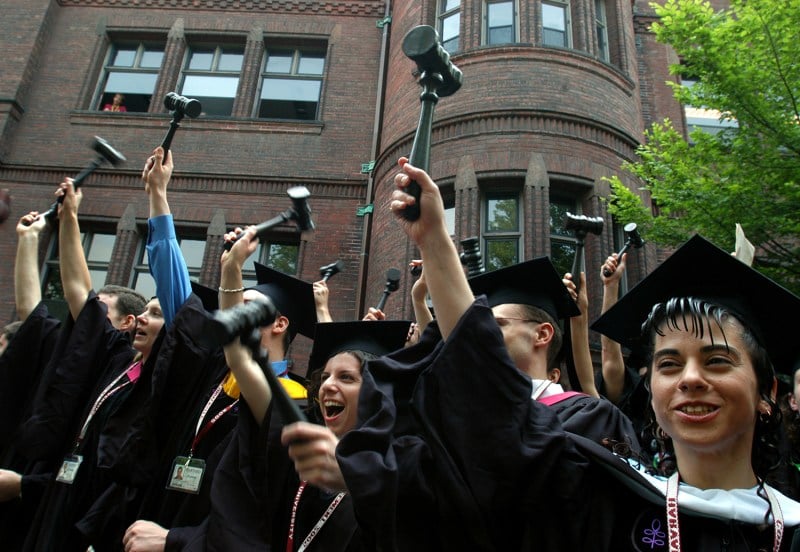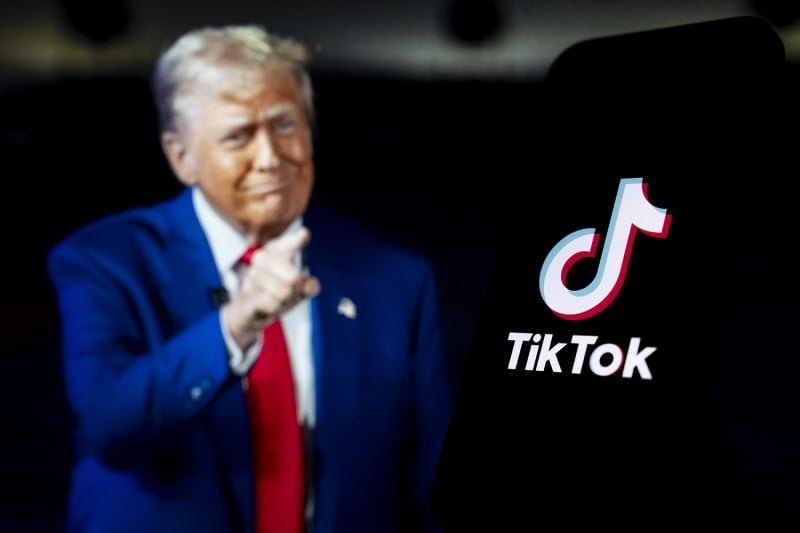Trump and the Business of Big Law

Trump and the Business of Big Law
The U.S. president is targeting some firms. Here’s how they work.
Harvard Law School graduates wave gavels in celebration during commencement events in Cambridge, Massachusetts, on June 9, 2005. William B. Plowman/Getty Images
The market for legal services in the United States was nearly $300 billion in 2024. It’s a major sector of the U.S. economy—and one that the Trump administration has recently targeted with a set of executive orders. Several orders target specific law firms that have opposed Trump in the past or assisted those he considers enemies; another more generally encourages the Justice Department to refer any attorneys for disciplinary action if they file “frivolous, unreasonable, and vexatious litigation” against the government. The government’s outright pressure has put the basic stability of U.S. law firms into question.
Does the legal sector play a special role in the United States compared with other countries? Should the system be considered political or technical? And how fragile is the system? Those are just a few of the questions that came up in my recent conversation with FP economics columnist Adam Tooze on the podcast we co-host, Ones and Tooze. What follows is an excerpt, edited for length and clarity. For the full conversation, look for Ones and Tooze wherever you get your podcasts. And check out Adam’s Substack newsletter.
The market for legal services in the United States was nearly $300 billion in 2024. It’s a major sector of the U.S. economy—and one that the Trump administration has recently targeted with a set of executive orders. Several orders target specific law firms that have opposed Trump in the past or assisted those he considers enemies; another more generally encourages the Justice Department to refer any attorneys for disciplinary action if they file “frivolous, unreasonable, and vexatious litigation” against the government. The government’s outright pressure has put the basic stability of U.S. law firms into question.
Does the legal sector play a special role in the United States compared with other countries? Should the system be considered political or technical? And how fragile is the system? Those are just a few of the questions that came up in my recent conversation with FP economics columnist Adam Tooze on the podcast we co-host, Ones and Tooze. What follows is an excerpt, edited for length and clarity. For the full conversation, look for Ones and Tooze wherever you get your podcasts. And check out Adam’s Substack newsletter.
Cameron Abadi: Law schools seem to have a special role in the United States compared with other places in the world, serving as a sink for humanities majors of all kinds who may be unsure of what else to do after their undergraduate education. Is it like that anywhere else in the world? And is that an expression somehow of America’s basic litigiousness, the money sloshing around in the U.S. legal system?
Adam Tooze: I think it’s absolutely true that it’s different to anywhere else. In Germany, lawyers occupy a key position in the power structure, but according to Ezra Klein and Derek Thompson in [their new] book Abundance, there are twice as many lawyers per capita in the United States as in Germany and four times as many as in France. So the American story is different, and the law school system that feeds those people into the American economy, American society, is unlike anything that exists anywhere else in the world.
This hasn’t always been the case. It is tempting to fall into this argument of saying, well, America has always been like this, go back to Tocqueville in the 19th century and you see it. The key point to make is that there was a steady increase in lawyers in American society through the late 1960s. But then what happens is there’s this huge surge from the late 1960s onward. And this has added to their share of GDP.
I mean the numbers here are vague, they generally are. Folks argue that the share of lawyering might be between 1.3 percent to 1.7 percent of GDP. That would put you in the $350 billion range in terms of value added. So that’s, as it were, the value generated by legal professionals altogether. That’s about, maybe on a high side, perhaps twice their share of the workforce. So that figures in terms of productivity. You might think of them as relatively highly paid professionals. At the very top of the profession—a lot of the time when we’re thinking about lawyering in the United States or watching legal shows on TV, it’s about Big Law—there’s a listing of the biggest law firms in the United States, and if you look at that listing, the top 80 firms employ about 113,000 people, they generate $135 billion in revenue between them, which cashes out at about $1.3 million per lawyer in that Big Law system.
So, at that end, it’s a very rich business indeed, and the top law schools and the law school hierarchy and the treadmill of those are driven by preparing people who will be hired into that mill of Big Law.
CA: Could artificial intelligence do some of the work that associates—young lawyers fresh out of law school—have tended to do for law firms? And would that then change the entire model that we’re talking about because then you don’t even need the growth at least relentlessly that they’ve had in order to hire these associates into partnership roles.
AT: Yes, I think AI is clearly a threat to this profession, and thank God, good riddance. There’s an awful lot of routine checking, consistency checking, compliance checking, which currently requires legal eyes on it, whereas in medicine, there’s every reason to believe that an AI algorithm, a properly trained one, will have huge impact.
And of course, the lawyers are in the unique position that at least some of them, the most influential among them, will actually define the terms under which AI impacts what they do because what will define is, of course, a business calculation on the part of the law firms but also law. So, at some point, they’re in a position to pull the brake and say, you know, law requires that lawyers do lawyering. And there will of course be a shaking-out process, a market-driven process. But unlike some other professions, you would expect them in the end to be able to regulate this flow. I think the big risk is that it enhances winner-take-all logics in the legal profession as well, in that the firms that will be able to employ the best engines, the businesses that will be able to really harness this, will be the firms that already are able to invest the most in legal competition, legal warfare.
CA: How does the corporate structure of law firms affect how they work? Obviously, law firms are not traditional corporations—instead of shareholder value being the determining factor in making decisions, you have a partnership model of governance. How does that affect decision-making and strategy?
A lot of what they do is helping clients to avoid regulations, whitewashing reputations, avoiding taxes. Should those kinds of legal services, offered to corporations, even be considered in the same category as legal defense for individuals?
AT: I think the short answer is no, and they aren’t. I mean, that’s not what Big Law does, right? Big Law is essentially about that entire other realm that you summarize so well, Cam. Big Law is about corporate interests. Those are, generally speaking, best served by avoiding litigation by various types of more-or-less aggressive, under-the-blanket, inside-struggle [tactics] between similarly equipped corporations on the other side. Litigation, and the threat of litigation, is not with a view to achieving a final judgment but with a view to forcing an out-of-court settlement of some kind before you ever get there. And this has been rehearsed over and over again.
And there’s an entire logic, even with inside the government itself, of how far they want to go in terms of pressing well-lawyered large corporations, how much damage they’re willing to absorb when they risk taking companies to court. I mean, the nightmare case is the Arthur Andersen consulting firm that used to be like this dominant McKinsey rival in the 1980s, 1990s, and was just dissolved by the impact of the Enron debacle. And in the wake of that, apparently in the Justice Department, there was quite a lot of decision-making that said among lawyers that really in the future, they should avoid the disaster bringing down a major corporate player like that and do everything in the form of this corporate-to-corporate legal bargaining, rather than aggressive litigation, which is one of the ways, then, that they proceeded when they handled the financial crisis of 2008. All conflicts, all tensions, in American society at the high level are going to, at some level, have a legal component.
I’m speaking now as an employee of Columbia University, which is involved in precisely such a struggle with the U.S. government, which is threatening us with a variety of different suits, and high-powered legal teams on the Columbia side are strategizing about how best to respond. That’s where they earn their money, that’s where the big bucks are made, that’s what Big Law is about. It’s a key element of brokerage. In the United States even, if you look at the development of the foreign-policy apparatus in World War II, in its aftermath many of the key players of American globalism, in, you know, the emergence of America as a global power, they’re also lawyers. And when we think of businesspeople, quite often what we’re actually talking about is not somebody who runs a factory or somebody who does deals like Trump but somebody who is a lawyer who thinks through contractual arrangements. And that’s where much of the smarts of modern business practice actually resides. So, yes, ethical, unethical aside, in terms of managing conflict, managing tension, they play an absolutely crucial and comprehensive role.
CA: In this context, what role should we think that pro bono work plays? Pro bono work being the kind of volunteer work that law firms offer to those who can’t otherwise afford their services. I mean, is this basically to allow corporate law firms to present their work as attractive to idealistic young legal students? Is it basically a function of laundering Big Law’s public reputation ultimately?
AT: The astonishing thing is the answer is yes and they’re totally explicit about it. So you just have to Google that question, and bunches of articles in professional legal journals come up explaining to you that the advantage of a firm doing pro bono work is it’s great for recruitment, it’s good for corporate morale, it keeps people onside, makes you look good, you know, in so many words. It’s no secret. The question, I guess, is how much do they actually do? And the firms will trumpet that they do a huge amount. But you can actually cash this out because the American Bar Association has a target number of hours of pro bono work. They actually recommend a certain number, and it’s 50 hours per year.
So then the question is, how many billable hours does your typical senior lawyer clock up? And the recommendation in most major law firms is somewhere between 1,700 and 2,300 billable hours per year. So take the middle there. If people met the bar association kind of norm of 50, they would be doing just over 2 percent of their time on pro bono work. So 98 percent of the time would be for fee, 2 percent would be pro bono. If you actually look at what companies incautiously announce as, “We did these hours,” and then you translate that to the number of lawyers they’ve actually got on their books, you’ll find that, more often than not, the biggest firms do rather less.
Cameron Abadi is a deputy editor at Foreign Policy. X: @CameronAbadi
Adam Tooze is a columnist at Foreign Policy and a history professor and the director of the European Institute at Columbia University. He is the author of Chartbook, a newsletter on economics, geopolitics, and history. X: @adam_tooze
More from Foreign Policy
-

Zelensky stands before four Ukrainian flags; cameras are pointed at him. It’s Time for Ukraine to Accept an Ugly Peace
Seven things for Zelensky to keep in mind as cease-fire negotiations start.
-

Then-presidential candidate Donald Trump speaks before a capacity crowd at a rally for his campaign on April 10, 2016 in Rochester, New York. Trump Is Not a Revolutionary
Not all political upheaval is created equal.
-

German soldiers unload the U.S.-made MIM-104 Patriot surface-to-air missile system in Jasionka, Poland. The Latest Russian Missile Is Bad News for NATO
Oreshnik is a different beast from its predecessors.
-

French Emperor Napoleon Bonaparte leads the final assault by the Imperial Guard before his defeat at the Battle of Waterloo in what is today Belgium, on June 18, 1815. The Cost of Ignoring Geopolitics
Like Napoleon and the Ming dynasty, Europe is paying the price for strategic blindness.










Join the Conversation
Commenting on this and other recent articles is just one benefit of a Foreign Policy subscription.
Already a subscriber?
.
Subscribe
Subscribe
View Comments
Join the Conversation
Join the conversation on this and other recent Foreign Policy articles when you subscribe now.
Subscribe
Subscribe
Not your account?
View Comments
Join the Conversation
Please follow our comment guidelines, stay on topic, and be civil, courteous, and respectful of others’ beliefs.
Change your username |
Log out
Change your username:
CANCEL
Confirm your username to get started.
The default username below has been generated using the first name and last initial on your FP subscriber account. Usernames may be updated at any time and must not contain inappropriate or offensive language.